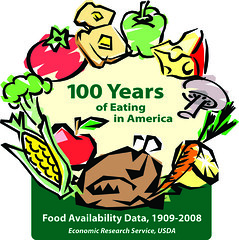This post is part of the Science Tuesday feature series on the USDA blog. Check back each week as we showcase stories and news from the USDA's rich science and research portfolio.
--------
When the prominent food writer Marion Nestle accepted an invitation to speak at our agency to mark the centennial of USDA’s data on food availability in the United States, it didn’t surprise me that her remarks would focus on the problem of obesity. It’s evident throughout her widely read “Food Politics” blog that she, like First Lady Michelle Obama, is particularly concerned about childhood obesity.

Marion braved a fierce New York snowstorm to be with us at the Economic Research Service on February 26 as we celebrated 100 years of data on American eating, in a product we call the Food Availability Data System. In her keynote speech at the centennial, she indicated that our food availability data are key to explaining obesity trends, referring to the data system as “one of the government’s real jewels.” The food availability data, housed on the ERS web site, are used by nutritionists, food scientists, public health professionals, and policy makers, among others, as a popular proxy for consumption for several hundred foods.
What we term “food availability” is essentially the per capita amount of food available for human consumption. Each year my colleagues and I add together the production and imports of individual foods, and subtract exports and farm and industrial uses of the foods, to arrive at an approximation of what Americans consume on average. For many commodities, we now have data from 1909 to 2008. And data since 1970 are also adjusted for food losses that occur at the farm level, in processing and transportation, and at the retail/restaurant and consumer levels, providing an even closer approximation of what is actually consumed. This latter data series also provides per capita calories per day for several hundred foods as well as daily per capita serving equivalents that can be combined for the different food groups and compared with Federal dietary recommendations.
The data system can tell researchers and other professionals that per capita cheese consumption, for example, has skyrocketed since the 1970s, and that carbonated soft drink consumption has seen a sharp rise since the 1940s, with a corresponding decline in milk consumption. Data users can compare diet with regular soft drink consumption. The system tracks per capita availability/consumption of vegetables over time, and users can look at numbers for the different varieties of vegetables. Users will find that just three vegetables – potatoes, tomatoes, and corn – continue to lead the pack. These are just a few examples of information that would likely be of interest to anyone concerned about obesity and diet quality.
We like to point out that this data product is the only source of long-term food availability in the country and continues to be a popular proxy for consumption. Along with my colleague Hodan Farah Wells, I invite you to visit the Food Availability Data System on the web and explore a wealth of information on a century of American eating. A new audio-visual presentation on the site demonstrates some examples of what you can do with this unique data system.
Jean C. Buzby, Economist, USDA’s Economic Research Service
